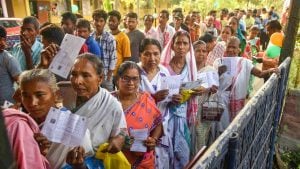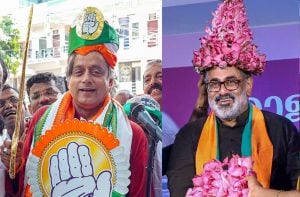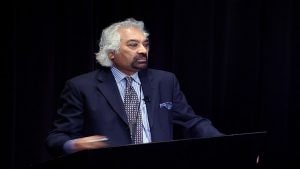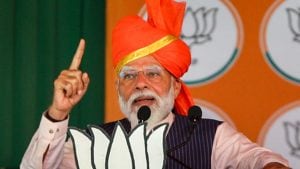Supreme Court verdict on EVMs — why upholding the voter’s trust is important
Summary
The Supreme Court verdict on the petitions against use of EVMs, seeking counting of 100% of VVPATs slips and return to the earlier practice of paper ballots, on Friday should put an end to the controversy around the alleged manipulation with machines and the process. It is time for political parties to continue to work with the Election Commission of India in the march towards ensuring a robust system keeping in line with changing technology and uphold the voter’s trust, observes political analyst and writer K V Prasad.
The decision of the Supreme Court on Friday rejecting a plea to count 100% of the slips generated by the Voter Verifiable Paper Audit Trail (VVPAT) and return to the previous system of voting through paper ballots should put an end to the current controversy on voting through Electronic Voting Machines.
The verdict by a bench of Justice Sanjiv Khanna and Justice Dipankar Datta rejecting the prayer, brings to a close a discussion. It centred around the efficacy of the EVM system and on integrity of the process that surfaces intermittently around elections to the Lok Sabha and to those of State Assemblies.
Political parties, which have suffered electoral reverses have at different times raised doubts over the EVMs and knocked the doors of the courts seeking intervention. Over the years, several additional safeguards have been incorporated into the process of voting through EVMs in order to address concerns including a sample count of VVPAT slips, a mechanism arrived at with scientific inputs.
This time too, new checks have been introduced for candidates who have questions over the result. The direction to preserve the data on the machines for 45 days and a provision to cross-check would strengthen the system and address concerns.
In addition, to address the issue of demands to cross-verify the slips generated by the VVPAT with votes recorded on the machine, a suggestion of generating party-specific barcodes was articulated. For a country known for its strength in the world of Information Technology, additional security features to keep pace with the changing technology and pitfalls associated with it can be done to ensure the process is not vitiated.
Conduct of voting through paper ballots was the mainstay of Indian elections since the first general polls in 1951-1952 amid concerns towards the later part of 1970s. Considering the logistics, complaints of booth-snatchings, stuffing of the ballots deploying muscle power, were required to be addressed.
To provide an instance on the use of EVMs and its efficacy both in terms of time and resources, former Chief Election Commissioner, Dr. S.Y. Quraishi in his book —An Undocumented Wonder: The Making of the Great Indian Election — noted; “ Aside from being voter-friendly and an excellent time saver during the counting process, EVMs are also environmentally friendly. By using EVMs in all the polling stations in the country in the 2009 general elections, 11,000 metric tonnes worth of paper was saved!”.
It is known that saving paper and reference to the environment is an apparent reference to the number of trees that would have been brought down besides, the resource involved in transporting the huge ballot boxes, safe-keeping as mandated under law even after the results and attending logistics would rise.
Take for instance, if voting was to be held with paper ballots in the current round of elections with nearly 97 crore of citizens with the right to vote, would require the ECI to print as many ballots. The size would vary depending upon the number of contestants, time consumed in exercising the vote and in counting these. In addition, the ballots which remain unused too, have to be preserved and eventually disposed of according to procedure of the process.
Besides taking care of the malaise of booth-capture and ballot stuffing, EVMs have speeded up both the voting and counting process. It also addressed the issue of invalid votes which at times led to delay in counting as poll agents of parties would dispute in deciphering the voter preference.
Now, different political parties should work together with the poll body in the march towards maintaining and consolidating voter’s trust in the process. The process of introducing EVMs is over four decades old. It happened only after political parties agreed to the provision of having machines to conduct elections.
-
- 1977: Chief Election Commissioner S. L. Shakdhar talked about introducing an Electronic machine.
- 1980-81: EVMs developed and demonstrated by ECIL and BEL.
- 1982-83: EVMs used for the first time in 50 polling stations of Parur Assembly Constituency in Kerala. And then in 11 Assembly Constituencies: 8 states, 1UT.
- 1984: SC suspends EVM usage: cannot be used till RP Act is amended.
- 1988: RP Act amended: enabling use of EVMs w.e.f. 15.03.1989.
- 2018: SC dismissed petition asking for return to Ballot papers!
(Source: Election Commission of India)
The experiment to conduct the most important part of elections, of the voter exercising franchise, actually began in 1982-83. But it took another five years to have the legislative backing for the move. First thought of during 1977, it took two years for the initial prototype to be developed and demonstrated to parties.
Paravur Assembly Constituency in Kerala was where the machine was utilised first in 1982, but its use in the election was struck down by the Supreme Court, since there was no provision in the Representation of the People Act, 1951 for EVM. After amendment to the law in 1989 and the end of another round of legal challenge, a consensus to use the EVMs was arrived at in 1998.
Then began the journey of EVMs and its gradual use in elections first to polls electing State Assemblies and finally across the country in the 2004 general elections.

Elon Musk forms several ‘X Holdings’ companies to fund potential Twitter buyout
3 Mins Read
Thursday’s filing dispelled some doubts, though Musk still has work to do. He and his advisers will spend the coming days vetting potential investors for the equity portion of his offer, according to people familiar with the matter


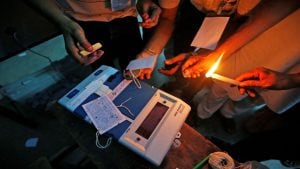






 Listen to the Article
Listen to the Article  Daily Newsletter
Daily Newsletter






